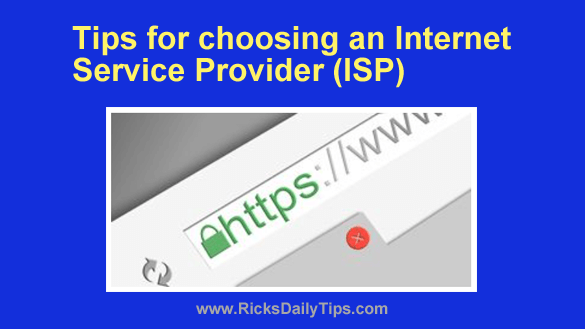 It hasn’t been all that long ago since most of us had only one choice when it came to Internet connectivity: an agonizingly slow dial-up connection through a standard telephone landline.
It hasn’t been all that long ago since most of us had only one choice when it came to Internet connectivity: an agonizingly slow dial-up connection through a standard telephone landline.
But times have changed. Nowadays virtually everyone in the United States can get a broadband Internet connection via their cable TV provider, the local phone company, a blazing-fast fiber optic connection or satellite Internet.
In fact, some folks even have the luxury of choosing between two or more broadband options simply due to where they happen to live.
If you happen to be one of them, you might be wondering how to choose between a cable, DSL, fiber or satellite Internet connection. Here are a few tips that might help…
First of all, if you have at least one of the other options available to you, I recommend dismissing the satellite option out of hand unless you’re willing to spring for Starlink.
To start with, except for DSL, download and upload speeds for traditional satellite Internet connections are usually slower than any of the other broadband technologies.
And to slow things down even more, there’s also a delay as your data is transmitted thousands of miles up to the satellite and back down to earth.
Satellite Internet customers can also lose their service during periods of heavy rain or when their dishes are covered with snow.
But perhaps worst of all, the monthly data transfer allotment with most traditional satellite Internet plans is effectively capped at a ridiculously low amount.
For all the reasons mentioned above, any satellite Internet service except for Starlink should probably be your last choice if you have a viable alternative.
At the other end of the desirability spectrum is fiber. Fiber optic cables can potentially deliver your Internet data at speeds that other widely available technologies can only dream about.
In fact, 1 Gigabit fiber connections are quite common in many cities and their surrounding areas, with even faster connections now available in select locations.
And as more fiber optic cables are installed across the country, those already blazing-fast speeds will likely increase even further due to competition among providers.
The other commonewewrrew high-speed Internet options are Cable Internet from your local cable TV provider and DSL from your local phone company.
Both cable and DSL are widely available in many parts of the country these days, with cable typically providing the faster upload and download speeds of the two.
In terms of quality of service, there is little difference between cable and DSL. They both tend to be quite reliable these days in most areas, but any given provider can provide poor service in a given area.
If you’re trying to choose between cable or DSL I recommend asking your neighbors about the quality of service they receive and using their feedback to help you make an informed decision. After all, a faster Internet connection won’t do you much good if it goes out on you on a regular basis.
If the quality of the services you have to choose from is fairly equal, your choice between them will more or less depend on the data transfer speeds you need and how much you want to pay each month.
Note: Many cable Internet providers are now offering plans with 1 Gbps download speeds so it might pay to check to see if yours is one of them.
And now here’s one final thing to consider…
Local utilities all across the country are pushing “bundles” where you can get a discount for getting multiple services through the same provider (typically TV, telephone and Internet).
While you can usually save a few bucks by bundling your services, I don’t really recommend it unless your monthly budget is the most important factor to you, for the following reasons:
1 – If you get all of your essential services over the same physical cable, a storm or other catastrophic event that causes a problem with that cable will leave you without ALL of your services until the damage has been repaired. And in some situations those multiple outages can last days, or even weeks.
On the other hand, if your various services are handled by different companies the odds that you could potentially be without multiple services at the same time are greatly reduced.
2 – It’s quite rare that a single company offers the best features and reliability for each of the services they offer. For example, in many areas the best TV service is available via the local cable TV provider while the best Internet service is available over fiber.
Bottom line…
If you have any other broadband option available to you, I recommend that don’t opt for traditional satellite Internet. That being said, the afore-mentioned Starlink satellite Internet service from SpaceX is a game-changer in the satellite Internet market. Just be aware that startup costs for Starlink can be significant.
But if fiber is one of your options, choose it above anything else as long as they have a service plan that fits within your budget.
If you find yourself having to choose between cable and DSL, make your choice based upon the available data transfer speed options and your budget if the quality of service you can expect is roughly equal.